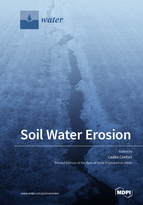Soil Water Erosion
A special issue of Water (ISSN 2073-4441). This special issue belongs to the section "Soil and Water".
Deadline for manuscript submissions: closed (31 October 2021) | Viewed by 43244
Special Issue Editor
Interests: ecosystem services; soil-related ecosystem services; soil erosion; land use change; nature conservation
Special Issues, Collections and Topics in MDPI journals
Special Issue Information
Dear Colleagues,
Soils are becoming the most precious natural resource of recent times. It is a well-known fact that we need to feed a growing population with decreasing quantities and a decreasing quality of soil resources. Tremendous efforts have been made by scientists to provide information about the protection of soils, but such information does not always reach the proper audience. Meanwhile, the technical development of tools and more detailed data has become widely available among scientists, which provides more accurate data on the state and processes of soil degradation.
The purpose of this Special Issue is to provide an opportunity for researchers to publish their novel results that could help landowners and land-users, farmers, politicians, and other representatives of our global society to protect, and, if possible, improve the quality and quantity of our precious soil resource.
We are expecting paper topics on new ways of mapping, maps with more detailed input data, new modeling results, maps about areas that have never been mapped before, etc.
We hope that this Special Issue provides novel results on the state of soil water erosion mapping and provides insight into new or easier ways for mitigating and restoring soil degradation. Hopefully, being open-access, this journal will reach the proper audience.
Prof. Dr. Csaba Centeri
Guest Editor
Manuscript Submission Information
Manuscripts should be submitted online at www.mdpi.com by registering and logging in to this website. Once you are registered, click here to go to the submission form. Manuscripts can be submitted until the deadline. All submissions that pass pre-check are peer-reviewed. Accepted papers will be published continuously in the journal (as soon as accepted) and will be listed together on the special issue website. Research articles, review articles as well as short communications are invited. For planned papers, a title and short abstract (about 100 words) can be sent to the Editorial Office for announcement on this website.
Submitted manuscripts should not have been published previously, nor be under consideration for publication elsewhere (except conference proceedings papers). All manuscripts are thoroughly refereed through a single-blind peer-review process. A guide for authors and other relevant information for submission of manuscripts is available on the Instructions for Authors page. Water is an international peer-reviewed open access semimonthly journal published by MDPI.
Please visit the Instructions for Authors page before submitting a manuscript. The Article Processing Charge (APC) for publication in this open access journal is 2600 CHF (Swiss Francs). Submitted papers should be well formatted and use good English. Authors may use MDPI's English editing service prior to publication or during author revisions.
Keywords
- soil degradation
- soil loss
- sheet erosion gully erosion
- soil carbon
- nutrient loss
- water erosion
- mapping
- modelling






